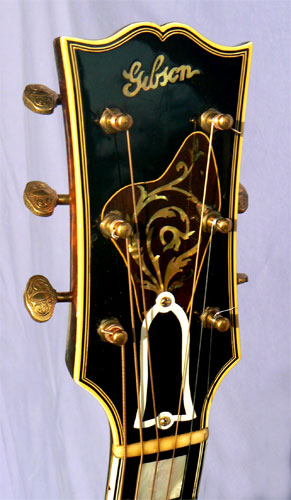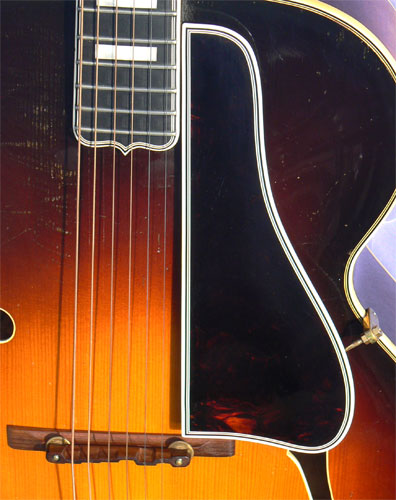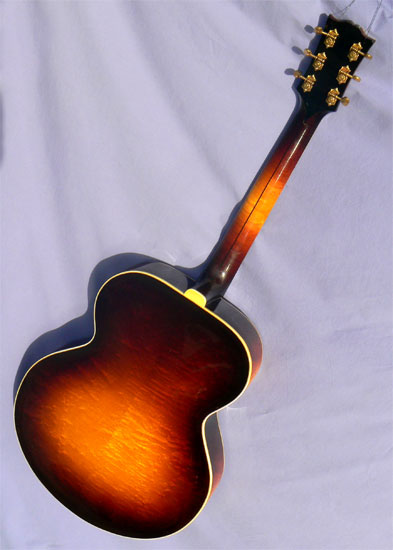
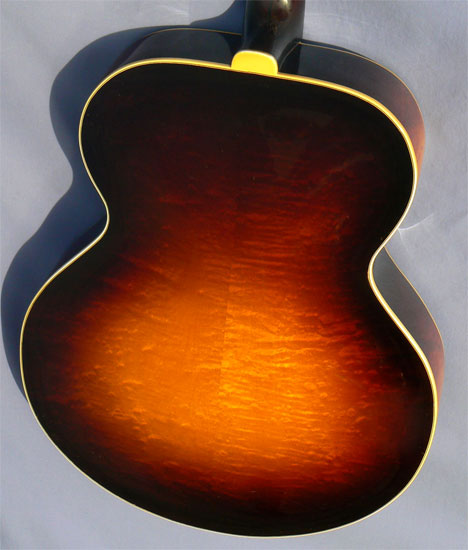
Home / Instruments /Accessories / Ordering / Tips / Friends
archtop.com
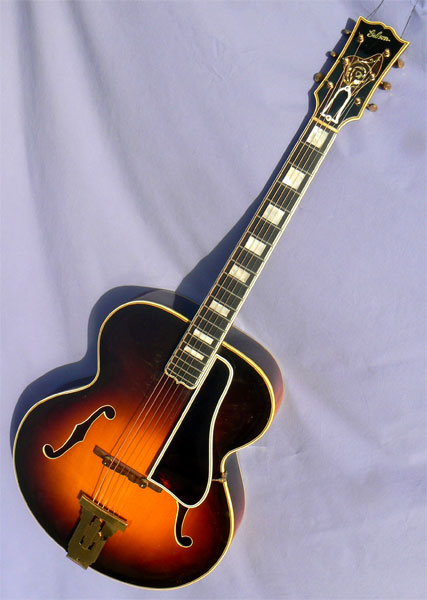
1942 Gibson L-5
Price and Status: For pricing and hold status of this instrument, please check here. If this instrument does not appear on the Instruments page it has been sold. To be notified of examples of this or any other model in the future, please email your specific requests to [email protected].
Serial #: 97649, white oval label. FON: 7611H-7
Body size at lower bout: 17", Scale length: 25 1/2" Nut Width: 1 11/16" Neck depth, 1st/10th frets: .91/1.02
Materials: Highly figured solid handcarved bubble figure maple back and sides; handcarved bookmatched solid spruce top; solid tiger flame maple neck; solid ebony fingerboard; block pearl fingerboard inlays; small script pearl Gibson peghead logo with floral inlay; triple-bound body, bound fingerboard and headstock, original bone nut.
Hardware: All original gold hardware includes engraved Grover Sta-Tite G-98 open back tuners, trapeze tailpiece with Varitone adjuster, multi-bound tortoise pickguard, compensated adjustable rosewood bridge, adjustable truss rod.
Notes: When Gibson throws you a curve, it comes in fast, and right over the plate. Once in a blue moon, we'd see a striking and most unusual inlay pattern on an older Gibson L-5. First on a custom 1935 model built for jazz pioneer Carl Kress. Then on this 1943 beauty owned by recording star Roy Smeck. An ornate floral wreath, sprayed in a swirl of multi-colored abalone, inset in a background of coffee colored rosewood. It was clearly the most elaborate inlay ever applied to an L-5. But where did it come from. And why?
Lloyd Loar, Gibson's legendary acoustic engineer, created two of the most influential fretted instruments of the 20th century: his 'Master Model' L-5 archtop guitar, and F-5 Florentine mandolin. But not all of his brainstorms were hits. Loar's original 1923 TB-5 Mastertone banjo did debut some clever innovations, including a 'trap-door' resonator shell, ball-bearing tone ring, and a new peghead, presumably designed to create a straight string pull from the tuners to the nut. Shaped like an inverted bulb, this 'snakehead' design had enough room for an exceptionally ornate fern wreath pattern in stunning 'Japan pearl' abalone inlay. But the following year, Loar and Gibson parted company, and the firm redesigned its banjos entirely, introducing the scalloped peghead still in use today.
During the Second World War, the Gibson Guitar Co. adopted a new motto, proudly emblazoned on their pegheads: 'Only A Gibson Is Good Enough." For Gibson's management however, the slogan might more accurately have read: "Waste Not, Want Not."
By 1942, Gibson instrument output had slowed to a trickle, as the firm devoted itself to wartime materiel production. Only a skeleton crew was assigned to finish up back orders, making guitars from the war years the rarest of the 20th century. Materials were tightly rationed, so Gibson made creative use of its vast parts stock, making wartime instruments the most distinctive in design as well. Elegant inlays from the past were pressed into service, including the elaborate 'picture frame' fingerboard design on the L-7, L-10 and L-12 archtops, cannibalized from unsold Mastertone banjos of the late 1920's.
This intriguing guitar, with serial and factory order numbers both from 1942, is a dramatic example of that creativity at work. The tuners are the fanciest that Grover ever made, and are the only ones we've ever seen attached to an L-5. With keys hand engraved in a floral motif, these gold G-98 Sta-Tites were fitted only on the earliest Super 400 models, as well as Martin's top line OM- 45 orchestra guitars. And as the factory had evidently run short of the traditional L-5 'flowerpot' inlay, some creative soul meticulously excised the abalone wreath, and small diagonal script Gibson logo, from a first generation TB-5 tenor banjo, that had been gathering dust since the Coolidge Administration.
Wartime archtops are the rarest in the Gibson history, and this outstanding example is one of just 20 sunburst L-5s built that year. Long owned by Northwest instrumentalist Don Setterberg, she's been maintained in remarkably fine condition, with all its gleaming Cremona sunburst finish, handsome bubble maple back and sides, and tiger maple neck. The gold hardware is all original as well, and now brilliantly replated, with all original binding tight to the body. The instrument shows no cracks or repairs, and apart from some scattered pick marks, and the faint footprint of an old DeArmond floating pickup, shows only light playwear for an instrument of its vintage.
At barely over 6lb, the guitar is happily light in weight, with exceptional depth, resonance and clarity, and the power and projection of the finely aged, parallel braced spruce soundboard. The gentle C neck is full and rounded, with smooth, low action over fine original fretwork, and a fresh high precision setup. And a delightful plus: the original Geib striped 'aircraft cloth' hardshell case is every bit as lovely as the guitar it has protected so well for some eighty years.
A highly distinctive instrument from Gibson's scarcest era, and as rare an L-5 as you're ever going to see. One only: call now.
Setup: The frets have been precision leveled, recrowned and polished as required; trussrod tension and neck relief adjusted; bridge height adjusted; bridge compensation set; string slots at nut and bridge inspected and recut as necessary; bridge foot contour inspected and fit to top as necessary; bridge radius inspected and recurved as necessary; bridge wheels and tuners lubricated; fingerboard and bridge oiled; body and neck cleaned and hand polished.
This instrument is strung with medium gauge bronze strings (.013). The guitar will accommodate lighter or heavier gauge strings, according to preference. String action is set at 4/64" to 5/64" at the 12th fret, with moderate relief for acoustic playing with medium strings. The action may be lowered or raised to your requirements with the adjustable bridge.
Special thanks to Tony Marcus, and Paul Alcantara for their peerless sleuthing skills, as always.


